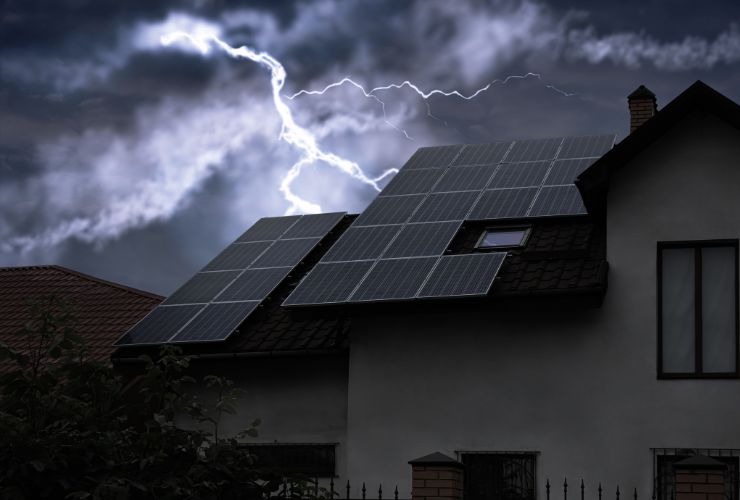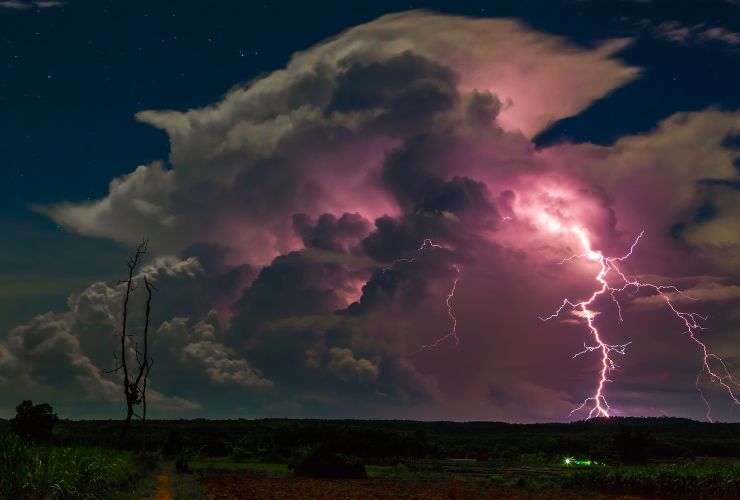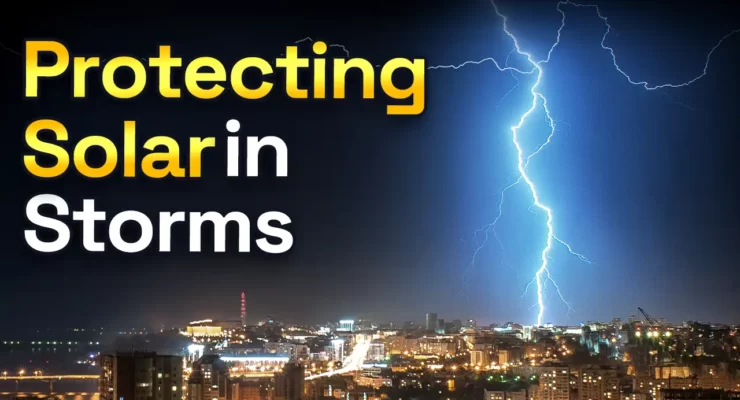Fast read
Solar panels do not attract lightning; they discharge electricity. Lightning's path is influenced by height, point, shape, and isolation level, typically seeking the shortest path to the ground.
Lightning rods don't attract but redirect lightning safely to the ground. To protect solar systems from potential lightning damage, consider installing surge protectors that divert or block surges, particularly those with Metal Oxide Varistors (MOV) that absorb excess energy.
Whole-house surge protectors, installed on switchboards, can also prevent surges from reaching household appliances. It's vital to ensure your solar inverter is grounded according to local electrical standards. Always seek professional advice for solar installations and safety devices, and hire licensed electricians for protection installations.
Can I protect my solar system from lightning damage?
Lightning is the discharge of static electricity between two objects to equalise the electrical potential between those two objects. A lightning bolt is designed to equalise the electrical charge between objects, such as between a cloud and the ground or between two clouds (sheet lightning).
This occurs when there is enough voltage for electrons to accumulate in the clouds while they are near the ground. However, the dynamics of lightning are a little bit more complicated than that and are also influenced by a number of factors. Including the cloud’s electrical field and air currents.
Solar panels installed on the roof of a home generate electricity but do not attract lightning or increase the risk of damage to the house from a lightning strike. Simply put, solar panels on metallic frames do not attract lightning. They are designed to discharge electricity, not attract it.
In the past, there was a common belief that lightning was attracted to metal objects, especially tall ones, such as umbrellas, aerials, or conductive materials. However, solar panels are no more likely to be struck by lightning than any other object.
Lightning is equally attracted to water, rocks, ground, soil, trees etc. The determining factors for where lightning will strike, put simply, are based purely on height, point, shape and the level of isolation of the contact point.
Lightning, like electricity, will follow the path of least resistance. This usually means that it will follow the shortest path to the ground.
What about Lightning rods?
Lightning rods are static discharge devices connected to the ground and placed above solar-electric arrays and buildings. These devices prevent static charge build-up and ionisation in the surrounding environment.
A common misunderstanding of this myth is that lightning rods are installed to attract and prevent lightning from damaging property. However, this is also not correct. The lightning rod’s purpose is in the rare case where a building is struck by lightning. It can channel the lightning to the ground/earth by creating the easiest and fastest path to the ground and preventing damage to the building/structure or occupants.

Can I still protect my solar system from lightning?
Surge protectors
One of the best ways to protect your solar inverter from lightning damage is to as the installer also to install a surge protector. Surge protectors will protect sensitive equipment from spikes or surges that could damage microchips and capacitors.
They are installed on both sides of your inverter’s power circuit and ethernet cables. Surge protectors direct lighting to the earth or block the surge entirely. A qualified electrician can install such protection.
Metal Oxide Varistor (MOV)
A good surge protector should include a Metal Oxide Varistor (MOV). This electronic component acts as a voltage-dependent resistor at average operating temperatures but becomes extremely low-resistance if the voltage exceeds certain levels.
While simple and inexpensive, the MOV absorbs the energy in a surge, preventing it from damaging other devices in a circuit. Most solar installers can offer lightning protection systems, but it will add to the cost of the system, and you need to ask for it. Remembering that surge protectors should be replaced every five years is important because they wear out over time.
Protecting your building’s grid power supply is vital so surges don’t reach other electrical equipment. Whole-house surge protection can be used for this purpose.
The whole-house surge protector is installed on your switchboard. It can divert power surges to the ground from your grid before they reach your home or solar inverters via the power lines. This will protect them from damage and keep you from losing solar production during lightning strikes.
If installed on your house’s main electrical feeder lines appropriately, whole-house protectors can handle heavy surges from nearby lightning strikes. A licensed electrician must install such protection. Doing it yourself is an absolute no-no in such an instance, you could be injured or worse if it goes wrong.

Grounding your inverter
Making sure your inverter’s metal parts are connected to the ground in your home is super important. It keeps everything safe and working properly. You need to follow the rules and guidelines set by your local area when you do this.
When you’re installing the inverter, make sure the metal parts are connected to the ground according to what your local rules say. Usually, this means connecting an electrical wire from the inverter to a special grounding spot. Such as a metal rod in the ground or the main grounding system in your house.
This grounding thing isn’t just about safety. It also helps stop electrical problems and makes sure your inverter works well. By following the local rules, you can make sure your inverter keeps running smoothly and safely in your home. Could you ask your certified solar installer about the best method to do this?
So can you protect your solar system from lightning?
Overall, solar panels do not create static electricity. They create current electricity as an electrical charge that flows through solar panel conductors, busbars and ground wires.
Properly installed solar panels will not create a static charge which is why you can touch the surface including the frame of the panel without getting an electric shock. Even though solar panels don’t attract lightning, they can still be hit by it, posing a risk of damage. Therefore, it’s important to take proactive measures to reduce the risk of damage in the event of a lightning strike.
